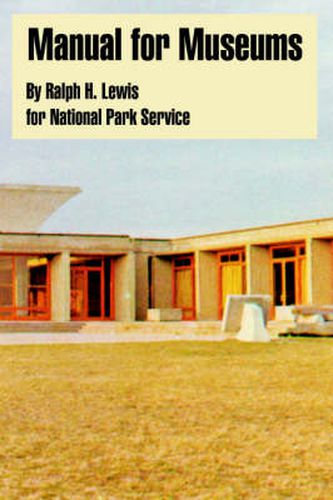Readings Newsletter
Become a Readings Member to make your shopping experience even easier.
Sign in or sign up for free!
You’re not far away from qualifying for FREE standard shipping within Australia
You’ve qualified for FREE standard shipping within Australia
The cart is loading…






This title is printed to order. This book may have been self-published. If so, we cannot guarantee the quality of the content. In the main most books will have gone through the editing process however some may not. We therefore suggest that you be aware of this before ordering this book. If in doubt check either the author or publisher’s details as we are unable to accept any returns unless they are faulty. Please contact us if you have any questions.
Among the most important contributions the National Park Service has made since its founding in 1916 has been the development of extraordinary museum technology and administration—national in scope and international in influence. This manual, a distillation of what many persons have learned about the day-to-day operations of museums, is meant to provide curatorial standards and serve as a reference for museum workers everywhere. This book was written by Ralph H. Lewis, an outstanding museum administrator and curator with many years of experience in the National Park Service. It is an outgrowth of an earlier (1941) volume entitled Field Manual for Museums by Ned J. Burns, a work that went out of print during World War II and is, even to this day, in demand by curators and museum managers. In this present manual, Mr. Lewis carries on a tradition of excellence in museum practice that can be traced back to the mid-1930’s when Carl P. Russell set the basic pattern for museum work in the national parks. In those early years most park museums could not afford or were too small to engage a full time professional museum staff. Dr. Russell set up centralized laboratories staffed by curators and preparators and provided the parks with exhibition and preservation expertise from this pool. The ordinary maintenance and operation of the museums were left to the superintendents who managed the parks, and to the archeologists, historians and naturalists who interpreted them.
$9.00 standard shipping within Australia
FREE standard shipping within Australia for orders over $100.00
Express & International shipping calculated at checkout
This title is printed to order. This book may have been self-published. If so, we cannot guarantee the quality of the content. In the main most books will have gone through the editing process however some may not. We therefore suggest that you be aware of this before ordering this book. If in doubt check either the author or publisher’s details as we are unable to accept any returns unless they are faulty. Please contact us if you have any questions.
Among the most important contributions the National Park Service has made since its founding in 1916 has been the development of extraordinary museum technology and administration—national in scope and international in influence. This manual, a distillation of what many persons have learned about the day-to-day operations of museums, is meant to provide curatorial standards and serve as a reference for museum workers everywhere. This book was written by Ralph H. Lewis, an outstanding museum administrator and curator with many years of experience in the National Park Service. It is an outgrowth of an earlier (1941) volume entitled Field Manual for Museums by Ned J. Burns, a work that went out of print during World War II and is, even to this day, in demand by curators and museum managers. In this present manual, Mr. Lewis carries on a tradition of excellence in museum practice that can be traced back to the mid-1930’s when Carl P. Russell set the basic pattern for museum work in the national parks. In those early years most park museums could not afford or were too small to engage a full time professional museum staff. Dr. Russell set up centralized laboratories staffed by curators and preparators and provided the parks with exhibition and preservation expertise from this pool. The ordinary maintenance and operation of the museums were left to the superintendents who managed the parks, and to the archeologists, historians and naturalists who interpreted them.